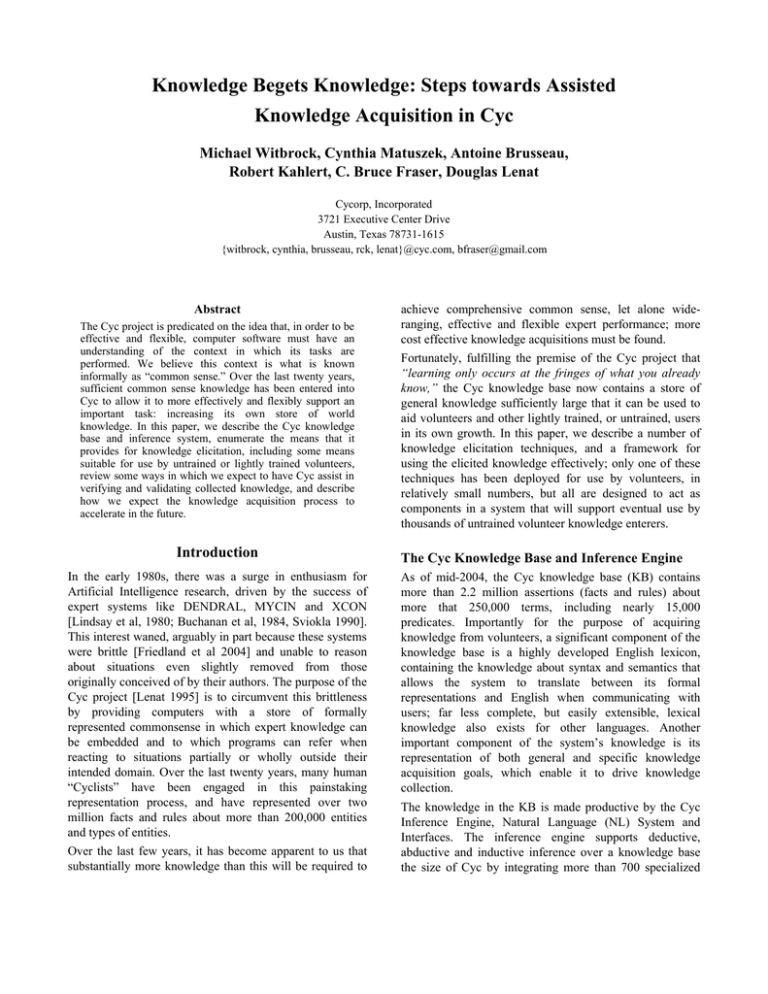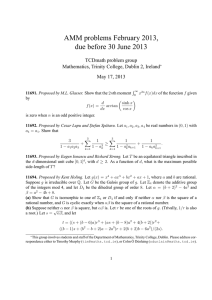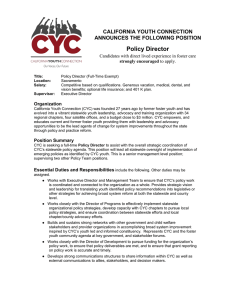Knowledge Begets Knowledge: Steps towards Assisted Knowledge Acquisition in Cyc
advertisement

Knowledge Begets Knowledge: Steps towards Assisted
Knowledge Acquisition in Cyc
Michael Witbrock, Cynthia Matuszek, Antoine Brusseau,
Robert Kahlert, C. Bruce Fraser, Douglas Lenat
Cycorp, Incorporated
3721 Executive Center Drive
Austin, Texas 78731-1615
{witbrock, cynthia, brusseau, rck, lenat}@cyc.com, bfraser@gmail.com
Abstract
The Cyc project is predicated on the idea that, in order to be
effective and flexible, computer software must have an
understanding of the context in which its tasks are
performed. We believe this context is what is known
informally as “common sense.” Over the last twenty years,
sufficient common sense knowledge has been entered into
Cyc to allow it to more effectively and flexibly support an
important task: increasing its own store of world
knowledge. In this paper, we describe the Cyc knowledge
base and inference system, enumerate the means that it
provides for knowledge elicitation, including some means
suitable for use by untrained or lightly trained volunteers,
review some ways in which we expect to have Cyc assist in
verifying and validating collected knowledge, and describe
how we expect the knowledge acquisition process to
accelerate in the future.
Introduction
In the early 1980s, there was a surge in enthusiasm for
Artificial Intelligence research, driven by the success of
expert systems like DENDRAL, MYCIN and XCON
[Lindsay et al, 1980; Buchanan et al, 1984, Sviokla 1990].
This interest waned, arguably in part because these systems
were brittle [Friedland et al 2004] and unable to reason
about situations even slightly removed from those
originally conceived of by their authors. The purpose of the
Cyc project [Lenat 1995] is to circumvent this brittleness
by providing computers with a store of formally
represented commonsense in which expert knowledge can
be embedded and to which programs can refer when
reacting to situations partially or wholly outside their
intended domain. Over the last twenty years, many human
“Cyclists” have been engaged in this painstaking
representation process, and have represented over two
million facts and rules about more than 200,000 entities
and types of entities.
Over the last few years, it has become apparent to us that
substantially more knowledge than this will be required to
achieve comprehensive common sense, let alone wideranging, effective and flexible expert performance; more
cost effective knowledge acquisitions must be found.
Fortunately, fulfilling the premise of the Cyc project that
“learning only occurs at the fringes of what you already
know,” the Cyc knowledge base now contains a store of
general knowledge sufficiently large that it can be used to
aid volunteers and other lightly trained, or untrained, users
in its own growth. In this paper, we describe a number of
knowledge elicitation techniques, and a framework for
using the elicited knowledge effectively; only one of these
techniques has been deployed for use by volunteers, in
relatively small numbers, but all are designed to act as
components in a system that will support eventual use by
thousands of untrained volunteer knowledge enterers.
The Cyc Knowledge Base and Inference Engine
As of mid-2004, the Cyc knowledge base (KB) contains
more than 2.2 million assertions (facts and rules) about
more that 250,000 terms, including nearly 15,000
predicates. Importantly for the purpose of acquiring
knowledge from volunteers, a significant component of the
knowledge base is a highly developed English lexicon,
containing the knowledge about syntax and semantics that
allows the system to translate between its formal
representations and English when communicating with
users; far less complete, but easily extensible, lexical
knowledge also exists for other languages. Another
important component of the system’s knowledge is its
representation of both general and specific knowledge
acquisition goals, which enable it to drive knowledge
collection.
The knowledge in the KB is made productive by the Cyc
Inference Engine, Natural Language (NL) System and
Interfaces. The inference engine supports deductive,
abductive and inductive inference over a knowledge base
the size of Cyc by integrating more than 700 specialized
reasoners for commonly occurring classes of sub-problem.
The Natural Language system uses both code and rules in
the knowledge base to support isolated and, increasingly,
discourse-based, translation of English words, phrases and
sentences into the CycL formal language, and generation of
English from CycL, both in isolation and in the context of a
proof. The interfaces provide convenient means for
knowledge entry and system query.
semi-interactive form (Figure 1, below) in which users can
enter simple statements in NL or NL fragments.3 Such
interfaces are particularly appropriate in cases where a
large amount of similar information must be entered.
Interfaces that provide a mechanism for populating specific
relations, such as typical sizes of objects, are an obvious
approach, and such a tool, the “typical size harvester” was,
in fact, produced at Cycorp to obtain constraining
knowledge for use in an information extraction system.4
Types of Knowledge
There are two substantially different kinds of knowledge
stored in the KB: ground facts and rules. Significant effort
has been expended on constructing tools designed to
reduce or eliminate the amount of training time required for
a user to generate new knowledge of each type. Ground
facts are comparatively straightforward to obtain and
represent, whether from an untrained user interacting with
the system via NL, or from a specialist trained in formal
representation. Rules are significantly more difficult;
trained Cyclists represent rules comparatively slowly, and
interfaces designed to elicit rules from untrained users
[Panton et al 2002, Witbrock et al 2003] have for the most
part been even slower and fairly ineffective in producing
productive, complex output. A compromise approach of
representing rule information as simple sentences
constructed with rule macro predicates1 falls somewhere
between the two in terms of difficulty. Work by other
groups in assisted rule authoring has also imposed
limitations on the complexity of the rules acquired [Baker
et al 2003, Tecuci et al 2002].
We believe that this difficulty in obtaining complex rules is
a general problem stemming from the mismatch between
the requirements of formal reasoning and the way humans
conceptualize their own reasoning processes. For this
reason, we are pursuing means by which Cyc can obtain
large numbers of ground facts from users, and can use
those ground facts to induce and then verify rules to be
added to the system2.
Obtaining Ground Facts
Acquiring Highly Structured Facts in a Domain. One
way of obtaining ground facts from users is to provide a
1
A rule macro predicate is a single predicate with a pre-defined
expansion into an implication. The simplest example is #$genls,
or “generalizes to,” which applies to collections of constants:
(genls ?A ?B) = (implies (isa ?X ?A) (isa ?X ?B))
2
In fact, we don’t believe that the situation for lightly trained
users is hopeless; in the latter stages of the DARPA RKF project,
we developed techniques for automatically transforming
descriptions of problem solving procedures into rules. These
“analysis diagrams” will be described in other publications.
Figure 1: The knowledge-driven Factivore™ interface
enables users to enter appropriate information about
instances of concepts – a particular restaurant in this
case – by filling out simple forms in English. These
forms are automatically generated from descriptions in
the Knowledge Base, some of which are produced
autonomously by inference. Visual feedback assures
users that knowledge has been effectively entered.; the
system, displays a “green light” and, where
appropriate, rephrases the entered information.
General augmentation of a KB with Cyc’s scope would
require an enormous number of such specific tools to
populate all the predicates used across its many domains; a
better approach has proven to be use of a general-purpose
template-based knowledge entry tool, the Factivore™. The
Factivore requires that new templates be written for any
given domain, but still requires far less per-domain expense
than building more focused tools. Because the template
specifies the expected underlying CycL representation,
3
This effort resembles Chklovski’s LEARNER [Chklovski 2003]
and the Open Mind project [Singh et al 2002]. The most
significant methodological difference is that, because the Cyc
effort is using an existing ontology, new facts are canonically
represented and are immediately available for use in inference,
requiring no post-processing.
4
Using the size harvester tool, 10 participants were able to
populate three concepts at the rate of 3000 assertions/month.
users of the tool need only fill in clearly defined blanks to
produce valid formal representations. These templates are
flexible enough to allow relevant knowledge to be properly
contextualized (e.g., specifying the specific interval when
Bill Clinton was president of the U.S.).
The Factivore has been successfully used on tasks as
diverse as project management (Cycorp project managers
have populated the KB with project staffing and task
information) and historical terrorism data (lightly trained
SMEs, some of them volunteers, entering information
about terrorist attacks around the world, have produced half
a million assertions [Belasco et al 2004] at an average factentry rate of 96 assertions/hour).
Acquiring Commonsense Type-Level Knowledge. A
class of knowledge that is difficult for untrained users to
describe readily in natural language is type-level
knowledge, such as “Croissants contain flour.” or “Cafés
sell coffee.” Although these statements certainly represent
commonsense knowledge, most SMEs have had difficulty
producing them without implicitly confusing the type and
instance levels5. This is representative of the difficulty
volunteers have describing rules, even rules as simple as:
“If there is a café, that café sells coffee.” Most such simple
deductive knowledge is captured by rule macro predicates
or type-level predicates:
(relationAllExists ingredients Croissant Flour)
=
(implies
(isa ?X Croissant)
(ingredients ?X Flour))
(agentTypeSellsProductType Cafe-Org Coffee-Hot)
=
(thereExists ?X
(implies
(isa ?Y Cafe-Org)
(sellsProduct ?Y Coffee-Hot)))
The difficulties encountered by volunteers in populating
this kind of knowledge (and the increased sophistication of
the underlying representation) suggests that doing so
qualitatively differs from the process of entering simple
ground facts. In this case, a template-based tool that offers
the opportunity to enter a single piece of knowledge is less
useful than a tool with lower cognitive load that offers the
user the ability to select among plausible choices. Efforts to
populate type-level predicates can benefit from automated
mechanisms providing a set of options from which the user
may select.
The first such tool developed was the Predicate Populator.
This tool (shown in Figure 2, below) looks at web pages
5
In RKF Years 2 and 3, we discovered that untrained SMEs
generally could not distinguish generic singulars from instances
without coaching.
Figure 2: The Predicate Populator is populated from a
combination of predicates and collections found in the
Knowledge Base and information gathered from web
pages about those collections.
about collections, such as “Café,” and makes a list of all
proximate nouns that are known to correspond to Cyc
collections matching the argument constraints for the
predicate in question.
Without the knowledge base’s preexisting base of Natural
Language lexical assertions, the system could not
automatically match terms in the knowledge base to those
found in natural language corpora to select appropriate
choices. The rate at which positive facts were asserted into
the KB by the Predicate Suggestor was approximately 400
facts an hour, or 7 per minute, while the rate of suggestions
that were deemed “inappropriate” (i.e., that should have
been rejected before reaching human review) as opposed to
simply factually incorrect was quite low6:
Total
Reviews/
Hour
6
609
True Skipped Inappropriate
414
167
28
While no metrics were gathered, it is worth noting that the
interest level of participants working on the Predicate Populator
tasks was much higher than that of participants asked to use the
Typical Size Harvester. In general, users asked to enter the typical
size of various objects found the task dull, while users asked to
select typical type information (such as what products are sold
where or what ingredients are found in foods) found the task
enjoyable. This may relate to the relative cognitive complexity of
the tasks, the difficulty of filling in blanks versus selecting from
presented options, the size of the trials conducted, or other
factors.
A disadvantage of both the template-based approach and
the more specific type-level tool approach is that they can
require significant preparation by ontologists.7 Although
each has produced significant improvement in the rate of
knowledge entry, large numbers of ground facts would
ideally be obtained from text corpora, or from volunteers or
untrained enthusiasts, and that rules be concluded from that
data. Satisfying such a goal cost-effectively precludes
significant OE involvement in preparation.
Validating Non-Expert Knowledge. Although the initial
work on providing interfaces that non-experts can use is
promising in terms of time per assertion, it does not address
the question of validation. While the large-scale effort to
gather knowledge about terrorists and terrorist actions has
resulted in tens of thousands of useful assertions, it has also
resulted in many incorrect assertions. The system can take
advantage of the knowledge already in the Cyc KB to
identify some incorrect entries. Anything that is in direct
violation of existing knowledge can be automatically
detected and rejected. Acceptance of (isa Witbrock
LawnFurniture) ≡ “Michael Witbrock is a piece of lawn
furniture” would be blocked by a rule-macro (disjointWith
8
Animal ManufacturedProduct). When something is entered
into the Factivore that it does not understand, a functional
term describing that entry is created, which incorporates the
name that was given to it by the user and any type
information that can be extracted from the template, e.g.:
(InstanceNamedFn “Roger Dodds” Person)
(InstanceNamedFn “Federal Republic of Germany”
GeopoliticalRegion)
When a terrorist act is described as happening in a country
that Cyc has no knowledge of, it is probable that a
knowledge entry error has occurred, either in parsing or at
the user end. The majority of existing countries are
represented in Cyc (which claim is in turn described with
the predicate completeExtentAsserted.) However, when the
functional term refers to a person, it is probable that it
represents a legitimately novel individual.
A very straightforward approach addresses the validation
problem with voting audiences, where several volunteers
must agree on the answer to a question before it is taken as
fact. This approach presupposes that arbitrary volunteer
time is available. Approaches such as automatically
validating the information given by performing web
searches and attempting to find verification in other
corpora [e.g. Ji, 2000] have the potential to be less wasteful
of human time, but represent a more difficult problem.
Answering Questions and Validating Hypotheses
Automatically. Another approach to gathering knowledge
in Cyc is to hypothesize plausible sentences, based on the
knowledge already in Cyc, whose truth is not known. Such
sentences can draw on the breadth of the KB to produce a
much higher rate of non-arbitrary sentences. Given that
someone is an artificial intelligence researcher, and lives in
Austin, for example, it is plausible, based on abductive
application of rules already in the Cyc KB, to propose that
perhaps that individual is an employee of Cycorp9.
In theory, such sentences can be validated automatically
against other corpora, as with volunteer-entered
knowledge. In practice, providing the means for doing so is
still a very open research problem10. Fortunately,
evaluating the truth of a hypothesized sentence is a task that
is highly appropriate for interested volunteers. Since many
of the abduced suggestions are amusing, it is reasonable to
hope for sustained volunteer interest.
In the course of implementing and testing the suggestedsentence review tool, we found several other axes along
which a sentence can vary. Ultimately, we found that
everything the reviewers wanted to express about a single
sentence could be captured by five characteristics:
•
Comprehensibility: is a generated sentence easily
understood by a human knowledge worker? In
most cases, when a sentence is not clear, either the
natural-language generation is faulty or the
sentence makes use of a predicate that is intended
to express a non-natural structural or internal
concept.
•
Appropriateness: is a sentence something that
should have been found to be invalid during the
type-checking phase of generation? For example, it
would be inappropriate, if mildly entertaining, to
suggest that “Osama bin Laden is a triangle” or
that “Al-Qaida is affiliated with inference
parameters.”
•
Truth: is the information content of the sentence
sound? Many of the generated sentences, while
reasonable hypotheses, are simply false.
7
While Factivore forms can be produced autonomously by
induction over useful case and NL generation of field names,
such forms are less polished. The Predicate Populator requires
ontologist involvement in predicate selection. We expect to
improve the automation of the predicate selection process, and
some work on that goal has been done; for example, candidate
predicates can be selected based on their “inferential fecundity,”
or utility in inference, which is determined recursively by their
appearance in rule antecedents.
8
Which, admittedly, may not be eternally true.
9
Hypothesized sentences of this form have been generated in Cyc
by adding abductive reasoning capabilities to the Inference
Engine. Abduction takes advantage of rules in the knowledge
base to hypothesize facts that would result in known assertions.
10
To which we are seeking solutions in our work on Question
Answering systems.
•
Interest value: is the sentence saying something
that is worth representing in the system for further
reasoning, as opposed to an irrelevance, such as
“George W. Bush is sitting down”?
•
Plausibility: is the sentence something that seems
likely to be true, based on common-sense
evaluation rather than domain expertise? An
example of an implausible sentence might be, “Mel
Gibson is affiliated with Al-Qaida” – this might be
true, but seems improbable. Evaluating the
plausibility of a sentence is both subjective and
contextual; it remains to be seen, therefore,
whether evaluating the plausibility of sentences is
useful.
Figure 3: The Suggested Sentence Review Tool offers
abductively proposed hypotheses for review.
Using this tool, lightly trained reviewers evaluated 900
sentences. The rate of knowledge entry over that time
depended largely on whether reviewers were asked to
determine the truth of sentences (e.g., using Google) when
they did not know. If they were asked to skip such
sentences, the rate of review was approximately four
sentences per minute. On an unfamiliar corpus about
terrorist organization policies where reviewers were asked
to determine the truth of the sentences, the rate dropped to
one sentence per minute.
Obtaining Higher-Level Knowledge
Obtaining Rules Via Induction. While gathering ground
facts is inherently worthwhile, ground facts combined with
rules provide the largest part of Cyc’s ability to reason
about novel queries. Constructing correct new rules in a
formal representation system is a challenging task for
specialists; efforts to utilize lightly trained Subject Matter
Experts in rule generation, even with tools designed to
simplify the process, have not been notably successful
[Panton et al 2002, Witbrock et al 2003]. However, rules
can be automatically generated applying machine learning
techniques (e.g. the Inductive Logic Programming (ILP)
system FOIL [Quinlan and Cameron-Jones, 1995]) to
ground facts. The abductive sentence suggestor provides an
unusually large body of plausible but negative assertions,
which improves the performance of ILP over the
Knowledge Base enormously; applying FOIL to a set of 10
predicates drawn from the Knowledge Base generates a set
of approximately 300 rules.
These rules are not guaranteed to be correct. However,
while rule authoring may be very difficult for untrained
users of the system, rule review is feasible (although still
difficult). In early trials, a reviewer could evaluate an
average of twenty rules per hour. Of those rules, 7.5% were
found to be correct, and 35% were found to need only
minor editing to be assertible. For comparison purposes,
experimental work in RKF Year 2 and Year 3 showed that
human experts produce rules at the rate of approximately
three per hour.
Some of the difficulties users encountered in performing
this ranking task could be addressed by the design of the
review tool, a preliminary version of which is shown in
Figure 4 (following page). Defining the concept of rule
quality presented an unexpected source of difficulty.
Human ontologists produce and evaluate rules regularly as
part of manually building the knowledge base; it might
seem, therefore, that a definition of a “good” rule would
have evolved naturally over time. Standards for evaluating
the quality of a rule do in fact exist, but are largely implicit;
in order to obtain reasonable, consistent results, a better
definition of rule quality was formalized.11 A second
challenge was determining how many ranking categories
could be presented without either constraining the user or
forcing excessively fine-grained choices.
Rules are, furthermore, difficult to comprehend in the
abstract. Providing reviewers with concrete examples
helped them perform consistently, and when the option to
show an example was provided they invariably chose to
make use of it. Despite the promise of initial attempts at
rule review, it may never be a task that can be performed
well by amateur volunteers. An alternative approach would
be to abductively generate large numbers of cases in which
the rule would be valid, validate the hypothesized ground
facts in the antecedent of the rule, and, for those rule
exemplars whose antecedents are judged true, solicit
11
There are two characteristics relevant to determining the
goodness of a rule. The first is whether it is written at the correct
level of generality; the second is correctness, which can be
defined as predictive power over novel data in the domain.
new cases) and in situ (by allowing their use in proofs to be
disputed) validation of the rules. We are currently
extending existing ILP work for use in knowledge bases,
like Cyc, with an enormous term and predicate vocabulary,
and a representation grounded in natural concepts.
In future work, we hope to relieve even volunteers of the
task of adding ground facts to the KB, instead using Cyc’s
increasing ability to interpret written texts into formal CycL
to automatically add facts in areas where experience shows
that the knowledge obtained is consonant with that entered
using human volunteers.
Having spent twenty years manually constructing a
knowledge infrastructure that provides an inductive bias for
knowledge acquisition, we are increasingly applying our
efforts to reaping the benefits of that work to greatly
accelerate the rate and utility with which knowledge can be
acquired. We invite other researchers to make use of the
ResearchCyc platform to drive this effort forward.
References
Figure 4: A preliminary version of a system for
rule review, designed for internal use at Cycorp.
The structure of existing KB content is used to
drive the selection of clauses for rules induced
from ground facts.
judgments over the validity of the corresponding
consequent.
Once rules have been tentatively validated, it is our
intention to make them part of the Cyc KB, offering users
the ability to give negative feedback when such a rule is
used in the proof of a conclusion with which the user
disagrees.
Conclusions and Future Work
Although Cycorp has not yet deployed the knowledge
acquisition tools described here for use by large numbers of
volunteers, it intends to do so. We currently hypothesize
that the most productive activity for such volunteers will be
entering and validating ground facts in areas of common
sense knowledge that are partially but not completely
represented. The system’s ability to infer knowledge
acquisition goals from the state of KB content, and use
those goals to drive interface presentation, makes it an
active participant in its own construction. Having gathered
large numbers of ground facts, we intend to apply ILP
techniques to the production of inferentially productive
rules, and to perform both experimental (by construction of
Barker. K., Blythe, J., Borchardt, G., Chaudhri, V.K.,
Clark, P.E., Cohen, P., Fitzgerald, J., Forbus, K., Gil, Y.,
Katz, B., Kim, J., King, G., Mishra, S., Murray, K., Otstott,
C., Porter, B., Schrag, R.C., Uribe, T., Usher, J. and Yeh
P.Z., 2003, “A Knowledge Acquisition Tool for Course of
Action Analysis,” In Proceedings of the Fifteenth
Innovative Applications of Artificial Intelligence
Conference (IAAI-03), Acapulco, August 12-14 2003.
Belasco, A., Curtis, J., Kahlert, R. C., Klein, Charles,
Mayans, C., and Reagan, P., 2004, “Representing
Knowledge Gaps Effectively,” in Proceedings of the
Fourth International Conference on Practical Aspects of
Knowledge Management (PAKM 2004). Springer-Verlag,
2004. (in Press)
Buchanan, B. G. and Shortliffe, E. H., 1984, Rule-Based
Expert Systems: The MYCIN Experiments of the Stanford
Heuristic Programming Project. Reading, MA: AddisonWesley, 1984.
Chklovski, T., 2003 “LEARNER: A System for
Acquiring Commonsense Knowledge by Analogy,” in
Proceedings of Second International Conference on
Knowledge Capture (K-CAP 2003).
Friedland, N.S, Allen, P.G., Witbrock, M., Angele, J.,
Staab, S., Israel, D., Chaudhri, V., Porter, B., Barker, K.,
Clark, P., 2004, “Towards a Quantitative, PlatformIndependent Analysis of Knowledge Systems,” in
Proceedings of the Ninth International Conference on the
Principles of Knowledge Representation and Reasoning
(KR 2004). Whistler, 507-515.
Ji, J., 2000, Semi-automatic Ontology-based Knowledge
Extraction
and
Verification
from
Unstructured
Document[s], M.Sc. Dissertation, University of Florida.
Lenat, D. B., 1995, “Cyc: A Large-Scale Investment in
Knowledge Infrastructure, Communications of the ACM
38, no. 11.
Lindsay, R. K., Buchanan B. G., Feigenbaum, E. A. and
Lederberg, J., 1980, Application of Artificial Intelligence
for Chemistry: The DENDRAL Project. New York:
McGraw-Hill, 1980.
Panton, K., Miraglia, P., Salay, N., Kahlert, R.C.,
Baxter, D., and Reagan, R., 2002, “Knowledge Formation
and Dialogue using the KRAKEN Toolset,” in Proceedings
of the Fourteenth Innovative Applications of Artificial
Intelligence Conference (IAAI-2002), pp 900-905.
Singh, P., Lin, T., Mueller, E., Lim, G., Perkins, T. Zhu,
W.L., 2002, “Open Mind Common Sense: Knowledge
Acquisition from the General Public.” Proceedings of the
First International Conference on Ontologies, Databases,
and Applications of Semantics for Large Scale Information
Systems. Irvine, CA.
Quinlan and Cameron-Jones, 1995, Induction of Logic
Programs: FOIL and Related Systems, New Generation
Computing 13, pp 287-312.
Sviokla, J.J., 1990, “An examination of the impact of
expert systems on the firm: the case of XCON,” in MIS
Quarterly. V. 14 no. 2, pp 127-140. June 1990.
Tecuci, G., Boicu, M., Marcu, D., Stanescu, B., Boicu,
C., Comello, J., Lopez, A., Bonion, J. and Cleckner, W.,
2002, “Development and Deployment of a Disciple Agent
for Center of Gravity Analysis,” in Proceedings of the
Eighteenth National Conference on Artificial Intelligence,
2002, pp 853-860, Edmonton.
Witbrock, M. J., Baxter, D., Curtis, J., Schneider, D.,
Kahlert, R., Miraglia, P., Wagner, P., Panton, K.,
Matthews, G., Vizedom, A., “An Interactive Dialogue
System for Knowledge Acquisition in Cyc,” in Proceedings
of the IJCAI-03 Workshop on Mixed-Initiative Intelligent
Systems, Acapulco, Mexico, 2003. pp 138-145.



